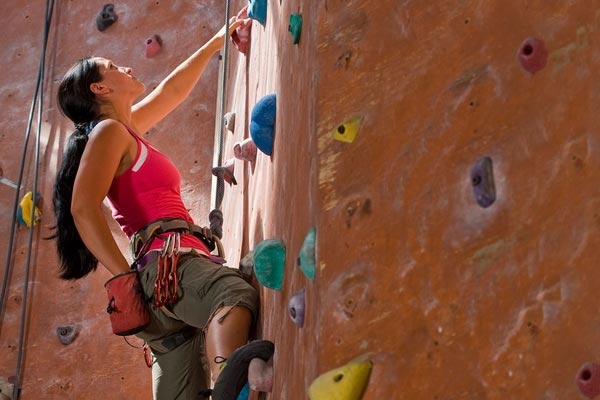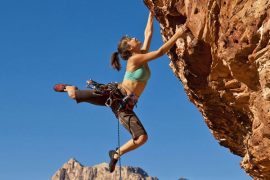Do you enjoy waking up each morning feeling like a badass? As most athletes can attest, the soreness that comes post full-body workout eventually becomes a craving, because it implies development and growth in all areas.
When we are constantly and consistently cultivating our full physical bodies, that drive trickles outward into the mental, emotional and spiritual aspects of our lives.
Rock climbing feels like a superpower when performed with knowledge, awareness and savvy. Who doesn’t want to feel and move like Spiderman?
Sometimes, a Youtube selection can better help us see the big picture: Big-wall and speed climber Hans Florine with Outside Television has long been established in the sport.
Down-to-earth and excited to share his passion with us, he goes over a ton of ways to improve your rock climbing game in detail with some very specific demonstrations. Check this YouTube video.
Never Be Afraid to Be a Beginner No Matter How Good You Get
It goes without saying that the basics are important. The warm-up is important. Those that claim themselves to be experts who never revisit the skills they learned in their foundation are merely touting their ego.
Honor, respect, and recall for the foundations are tantamount. Humbleness, humility, and honesty in any sport are the keys to progression.
All intermediate and advanced skills come from the daily practice of solidifying the basics, again and again, and again.
Seeing the rocky outcropping before us before the climb, as if for the first time is the pathway to climbing with an infinite sense of inspiration.
Here, Marta Brzosko talks about “How to Cultivate Beginner’s Mind to Become a True Expert” in rock climbing, in any and all of your personal and professional endeavors!
Now Let’s Get Down to Technicalities: Quiet Feet
One of the biggest flaws in technique that plague climbers finding their way to proper technique are noisy, heavy, stumbling feet that are constantly slipping off their footholds. To move quietly is to move lightly. To move lightly is to move precisely.
To move precisely is to be aware of how, how much, and at what angle every molecule of the foot through the climbing shoes is coming into contact with the rock. Concentrate on your foot placement, every single time.
Imagine your feet are getting to know the rock before it intimately. Developing quiet, agile cat feet that are in complete awareness of their surroundings is like developing intimacy with a lover.
The feet and hands are also direct channels to the mind, conveying infinite information about the climb and what is to come during the ascent.
Sander DiAngelis of Moja Climbing offers further insight into this integral tip here.
Strike up Rhythm, Exercise Momentum
Climbing like dancing. Whether you’re a dancer or not, it’s the truth! There is a natural, accessible sense of internal rhythm in all of us.
It may seem cliché, but the rhythm of the heartbeat itself is what allows us to recognize and create our own rhythms in all that we do. It is what maintains our sense of repetition and consistency.
It is what guides us quite literally to the next thing, this expectation that we know exactly what is coming and in exactly the right time.
This can be directly applied to the traverse upward. Cultivation of personal rhythm when climbing proportionately helps us develop a sense of fluidity in our movements that keep us from wasting energy on extraneous movements.
Check out Master Rock Climber‘s take on climbing with rhythm.
Climbing Pace: Not Too Fast, Not Too Slow to Start
It goes without saying that everyone climbs at a different pace. Especially when starting out, we each climb at different paces on different days depending on our energy level.
There’s a huge mental component that goes into setting a truly proper pace for your own unique progression.
There are strong arguments for both erring on the slower side of your range and speeding up to the faster side, depending on your level, and here we will talk about both:
A lot of beginners start out stressed out, worried that should they not maintain the pace they believe will allow them to “keep up” with their peers or partners, they will fall behind or have trouble finding climbing partners, or are not progressing adequately.
In truth, actively choosing a slower pace than your cardiovascular fitness can manage can open a whole new world for you in terms of what you are observing through contact with the rock (or wall) with your hands and feet, and the multitudes of information and understanding that you are able to send up to your brain through your contact points.
More often than not a slower pace makes for more precise and expansive learning opportunities and it is the observant athletes are taking the time to better feel into their bodies and observe their own inner body dynamics that succeed in the end.
Beck Rogers touches upon how to best find one’s ideal pace when first starting out.
For intermediate and advanced climbers, speed can also be used to enhance your climbing ability! Strength put into finger holds is not infinite; we have a limited amount of time that we are able to hold on and that is best not wasted on inefficient, plodding ascent.
What does “inefficient” mean you ask? Avoid touching holds more than once. Avoid readjusting your fingers on the hold. To do so reflects lack of decision and deliberation. Rock climbing is about the decision.
It is about seeing what’s before you and making quick, accurate and dynamic decisions about which line you choose to follow upwards.
It’s about choosing the right holds and placing your hands and feet deliberately and accurately the first time.
When you rest, rest deliberately, and when you’re climbing, climb deliberately. Streamline your thought processes. Avoid indecisiveness.
Commit to your decisions each and every time and make the best use of your strength endurance to go cover the most distance you can in the least amount of time.
Matt Lloyd of Mountain Strong Denver goes in-depth on mastering your climbing speed.
There are very few activities that develop the entire body and muscles we never even knew we had, and require such tremendous mental and physical flexibility, dynamism, and endurance.
Although done most often in pairs, it can also be a very solitary pursuit, as well as one that requires tremendous trust.
Awareness of subtlety and balancing potential vs. limitations are also in high demand.
In short, there’s nothing like getting to know yourself through rock climbing. We hope that your pursuits in it bring you growth, excitement, and contentment.

